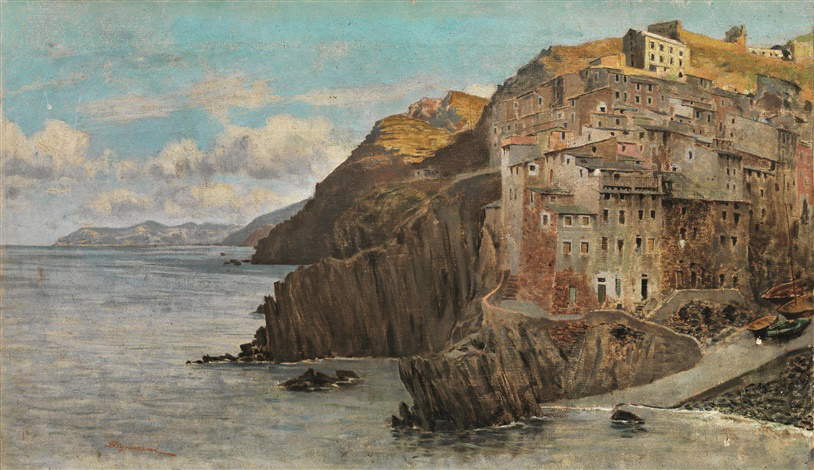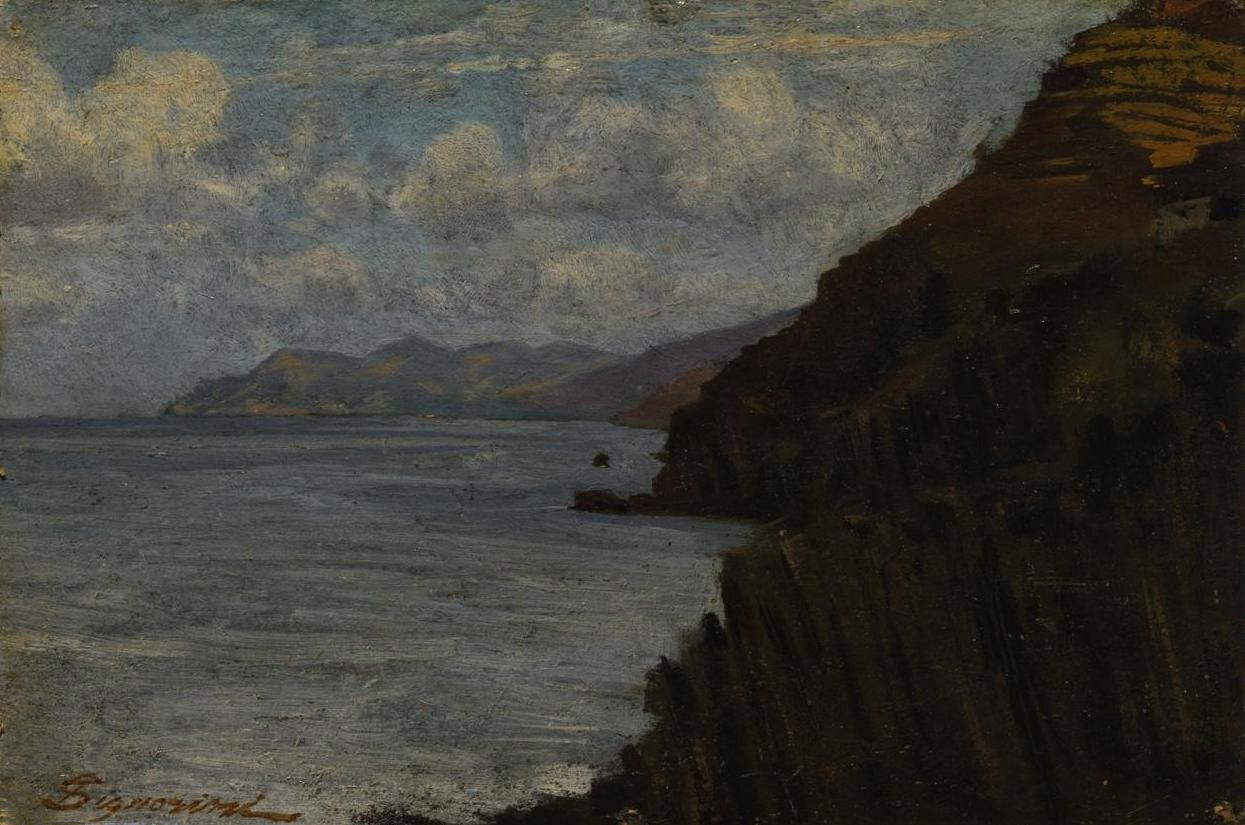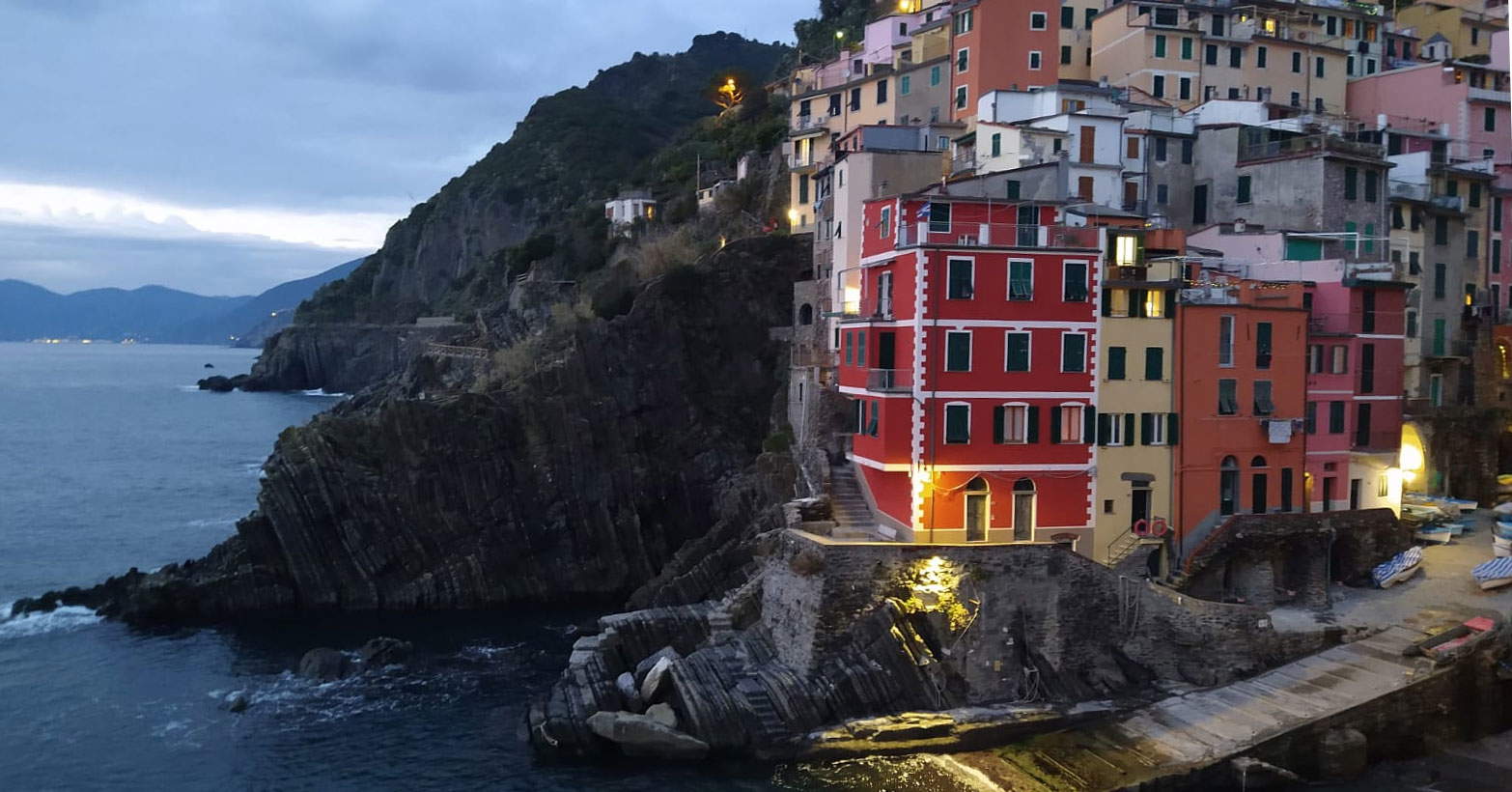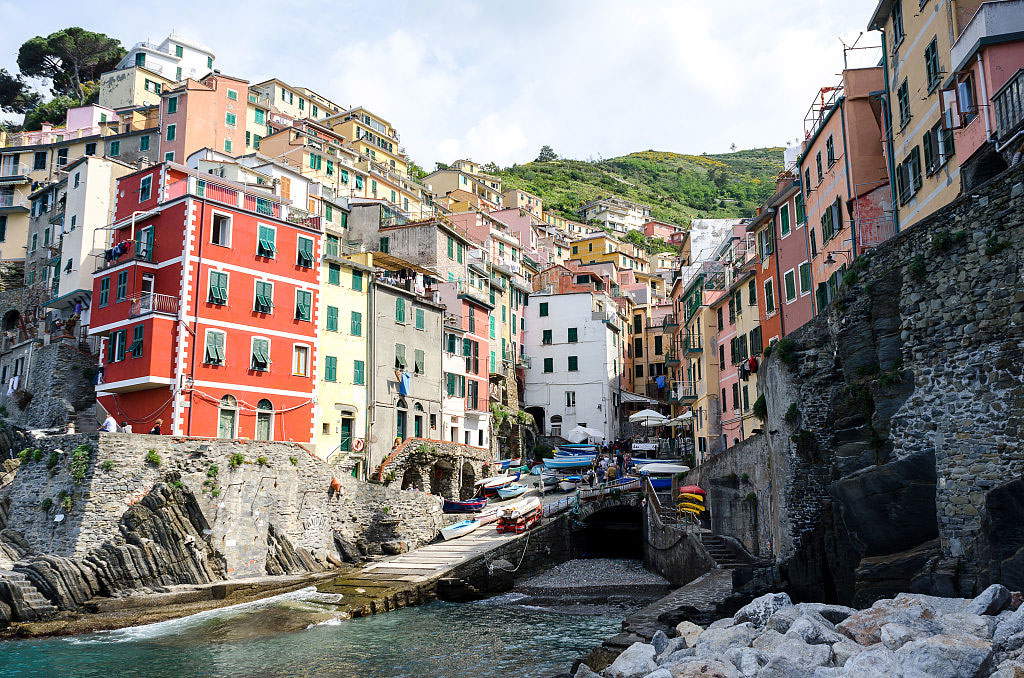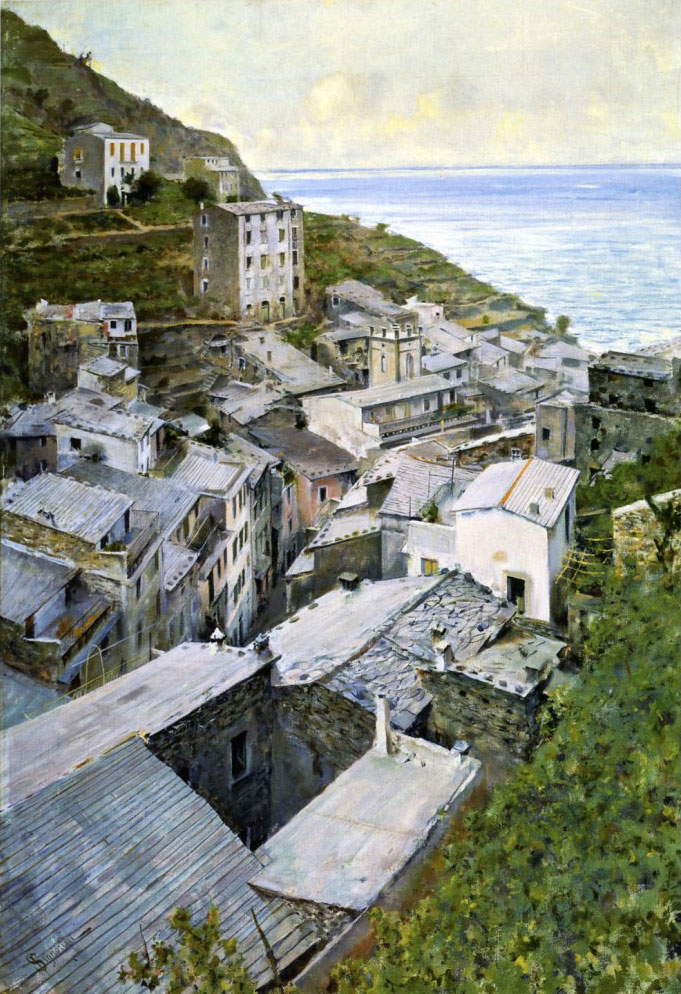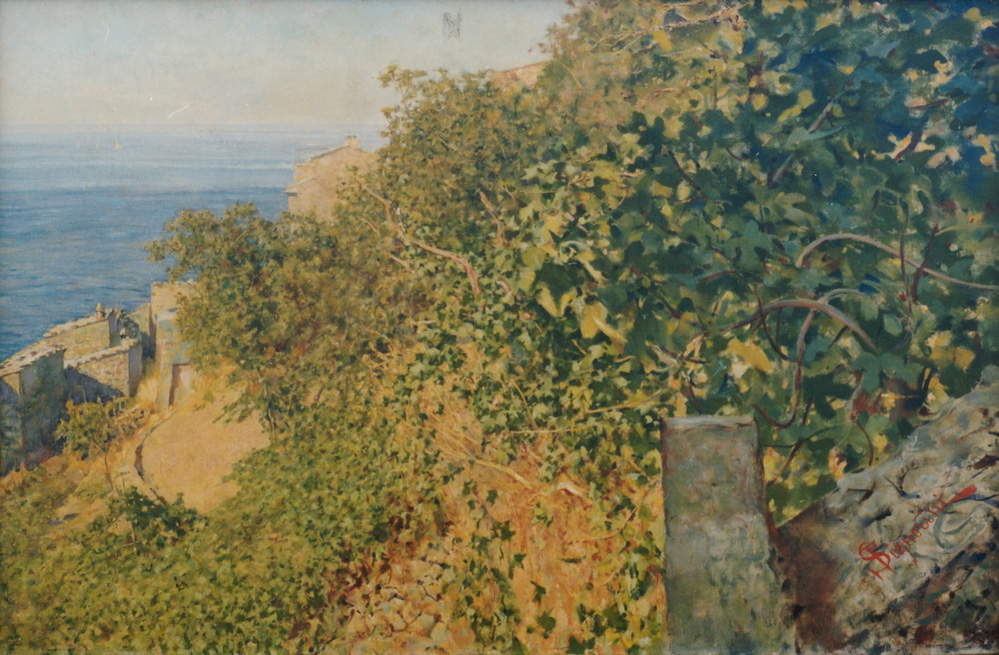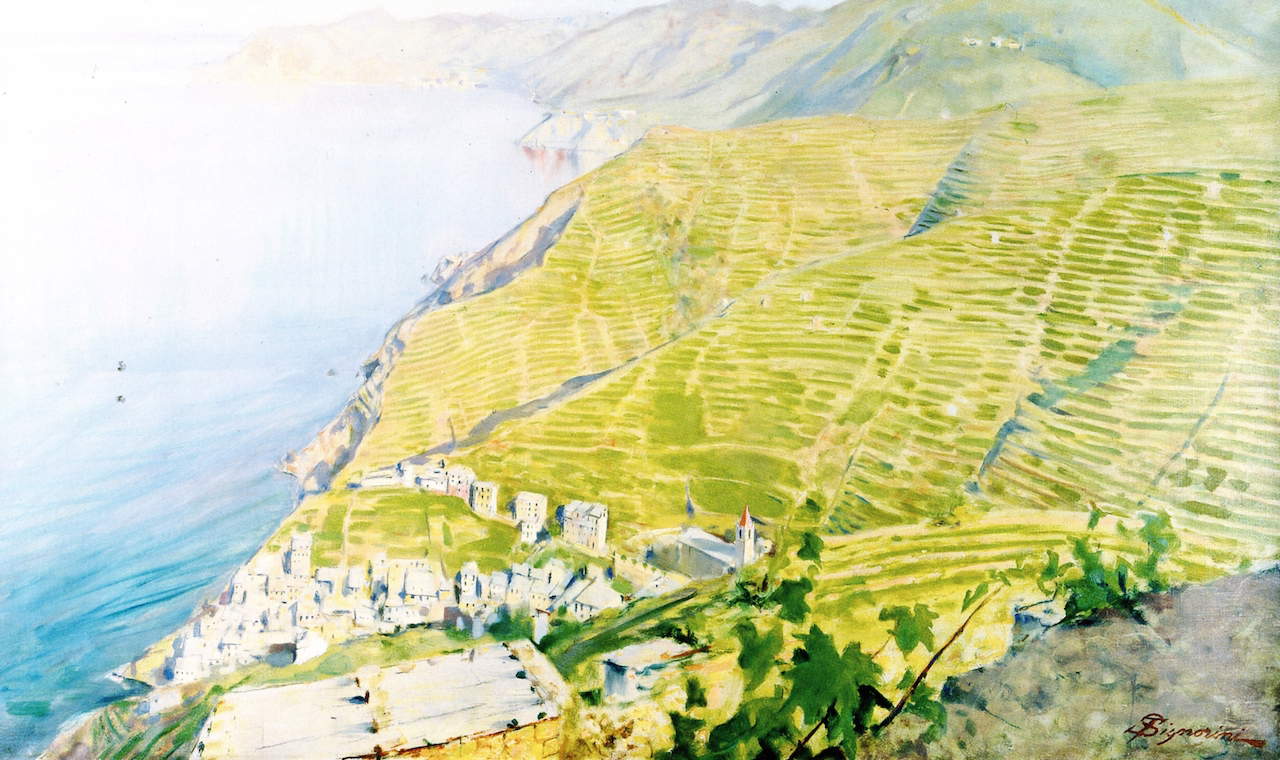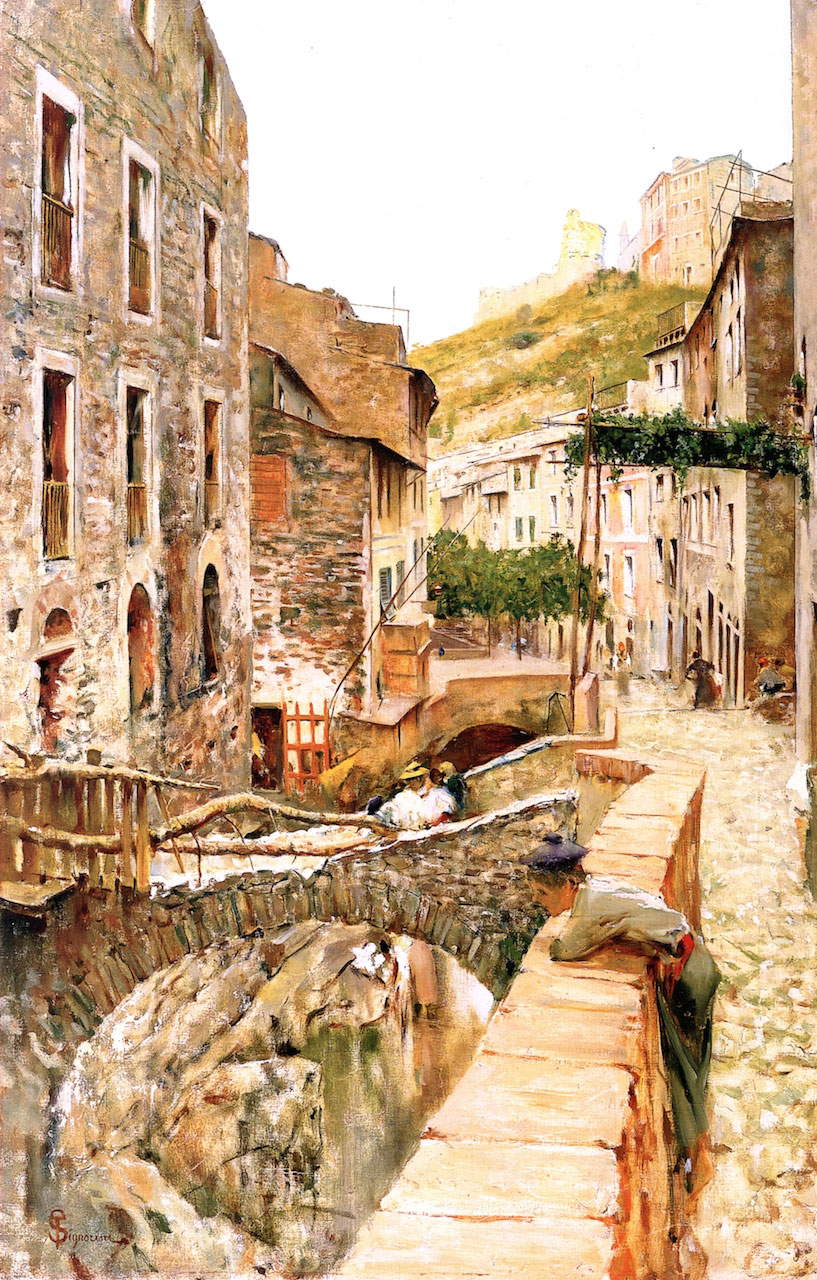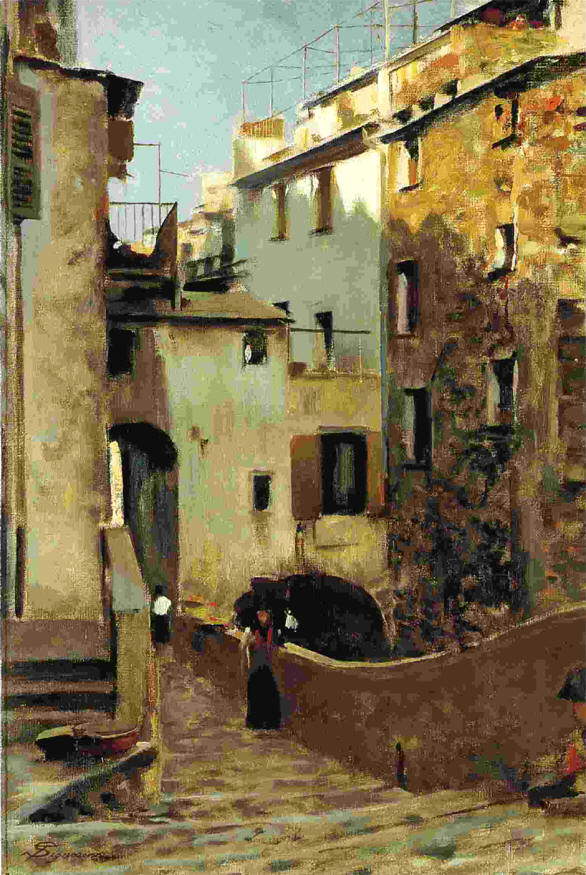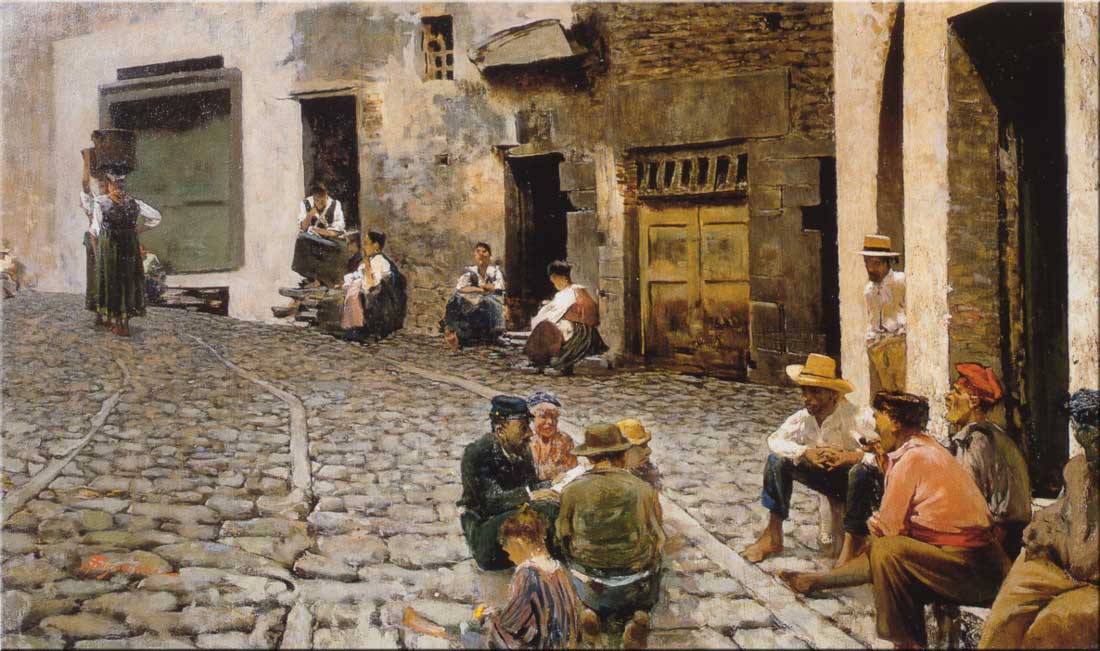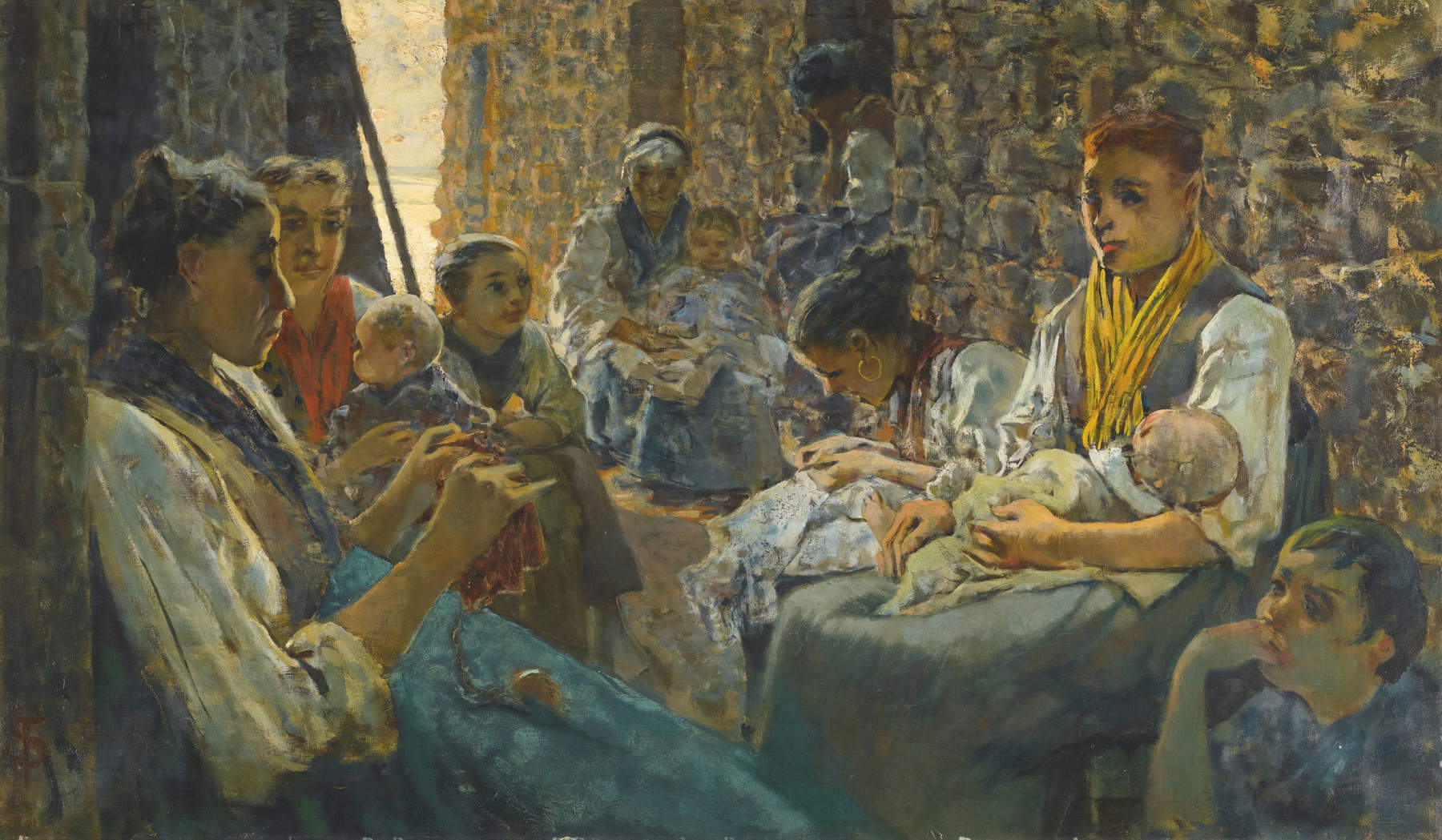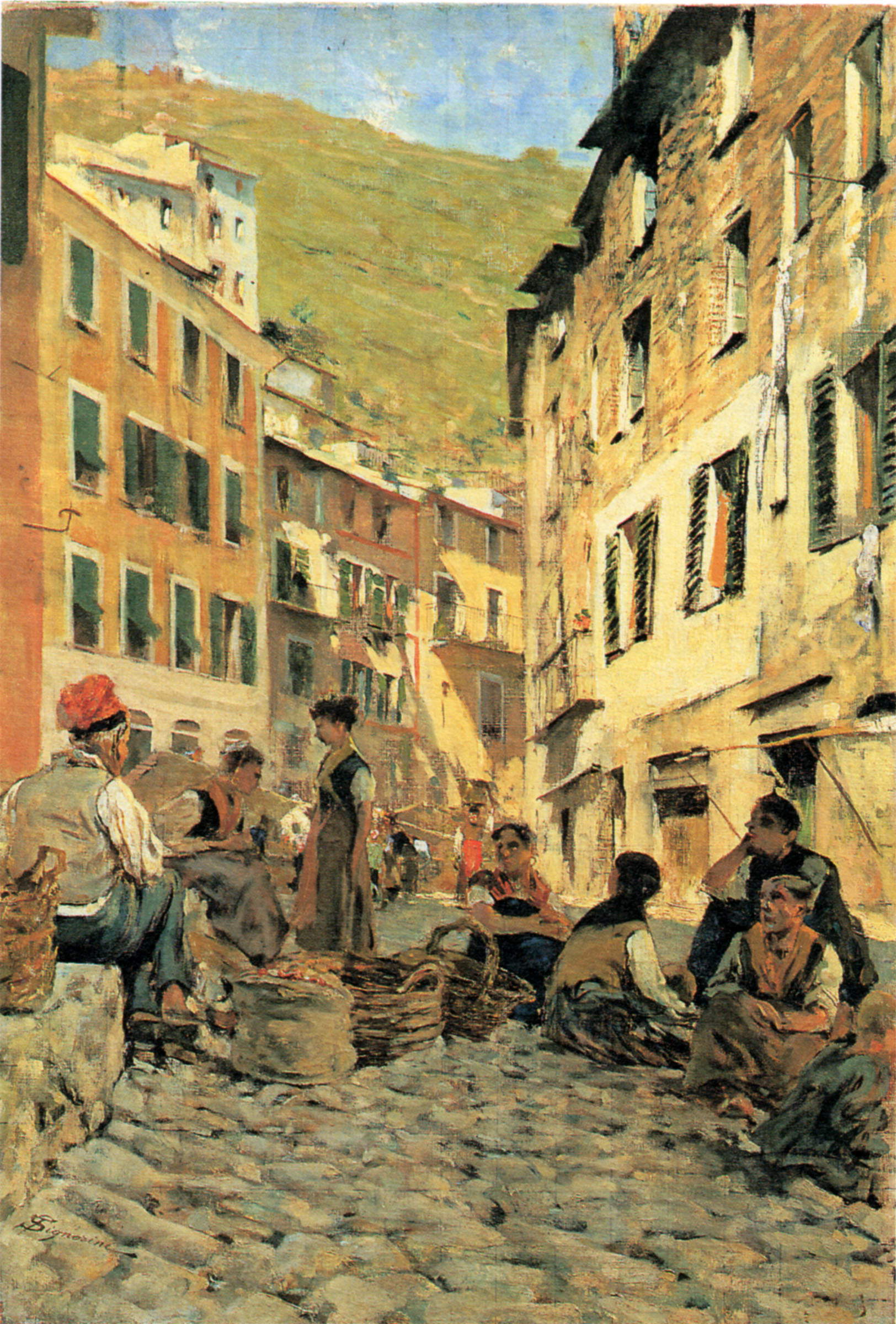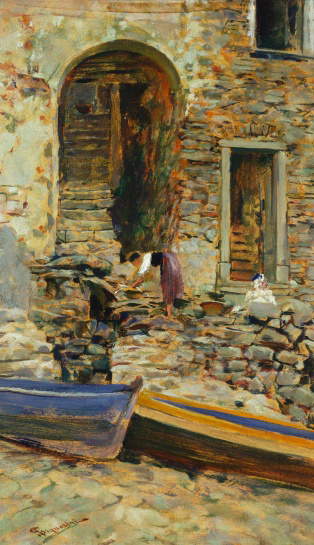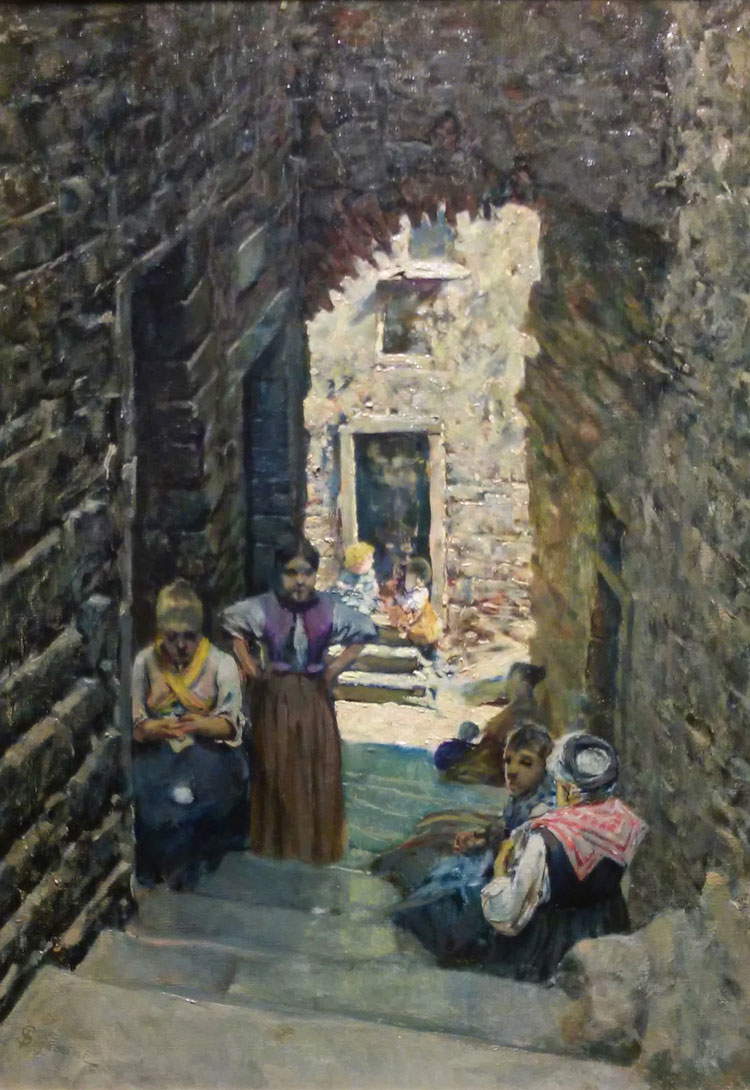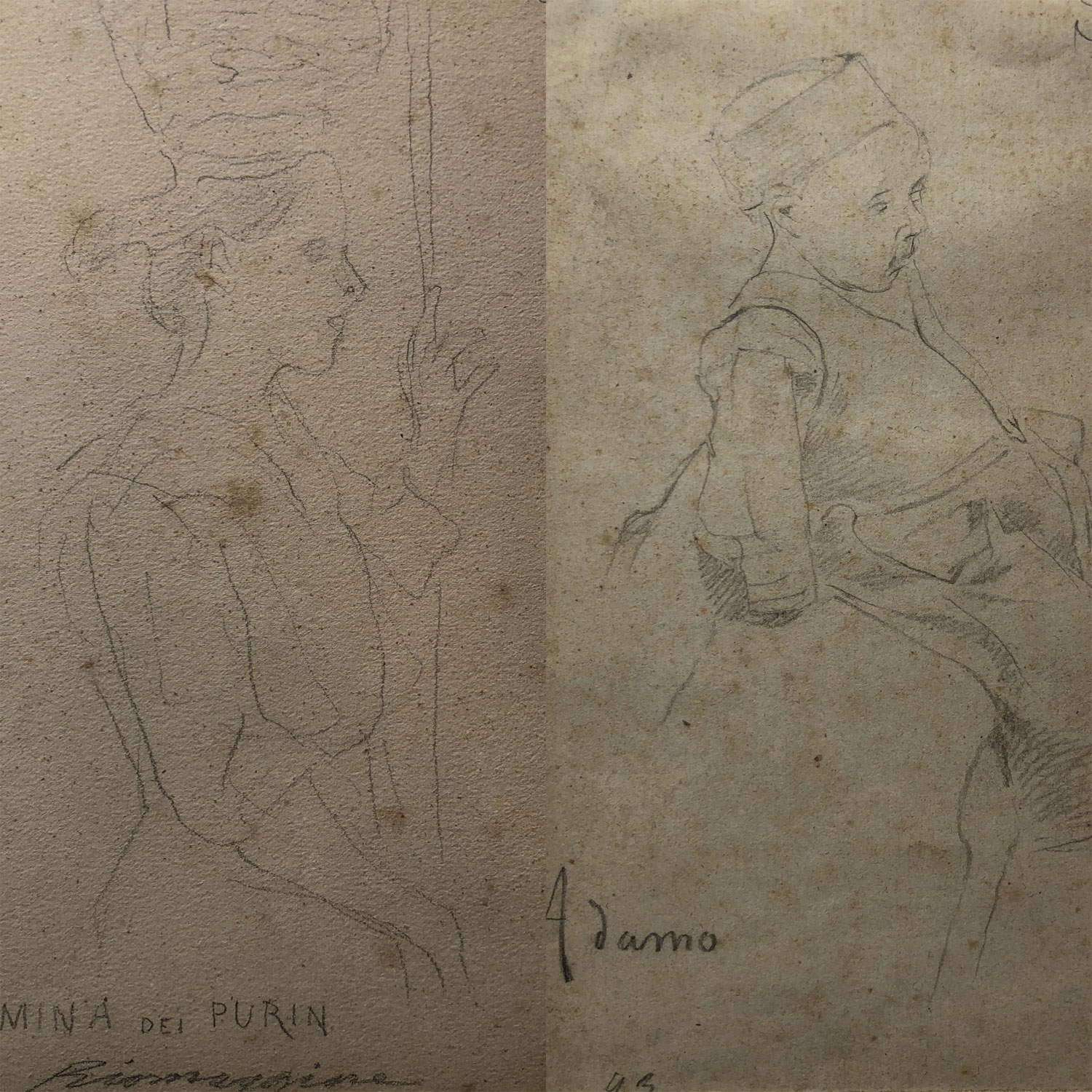by Federico Giannini, Ilaria Baratta , published on 14/08/2021
Categories: Works and artists
/ Disclaimer
Telemaco Signorini discovered the village of Riomaggiore in 1860: the artist found it to be an isolated village that was "resistant to civilization." But he fell in love with it, returned there on several occasions and contributed, with his paintings, to its discovery to the world.
Telemaco Signorini (Florence, 1835 - 1901) discovered Riomaggiore almost by accident. At the time, the first of the Cinque Terre was a peasant village that was very difficult to reach: one got there only by boat, or on foot through the roads and paths that run along the Porto Venere peninsula. It was 1860, Signorini was twenty-five years old and was staying in La Spezia to discover the villages of the Gulf of Poets together with two of his friends and colleagues, Cristiano Banti (Santa Croce sull’Arno, 1824 - Montemurlo, 1904) and Vincenzo Cabianca (Verona, 1827 - Rome, 1902). In his Diaries, which were first published in 1911 at the initiative of his brother Paolo, then in a luxurious 1942 edition and then again in 2020 in a handsome volume by Töpffer Edizioni, Signorini recounts that one summer morning the group met, at the market in La Spezia, some “women in a very strange and supremely pictorial costume.” They asked where they were from and discovered that they were from Biassa, a village exactly halfway between La Spezia and Riomaggiore, and asked if they could follow them to visit their village, but they were disappointed because from Biassa the sea could not be seen. “If you want to have a good view of the sea until you catch a glimpse of the Genoa light,” suggested a local boy, “turn the fort and you will arrive at the Montenero Sanctuary, from there you will see all the Cinque Terre.” They were thus guided to the sanctuary, where the view opens up to the tip of the Mesco, with Riomaggiore just below: this is how Signorini discovered the village where he would later return again and again.
Having arrived at the sanctuary, the three, moved by a desire to visit those places even more thoroughly, were not frightened by the steep descent leading to the village nor by the summer heat (“The sun no longer scorched us. The road, traveled in one breath, all stairs, seemed to us flatter than a farmhouse avenue”) and, “under a tropical sun,” they pushed on to Riomaggiore. The first impact, however, was not the best: Signorini, Banti and Cabianca immediately met with the mistrust of the people of Riomaggiore. “The first three Achaean corsairs who centuries back descended among these cliffs and planted Riomaggiore there,” the great Macchiaioli painter recounts again in his diaries, “must not have frightened the few wandering shepherds they found there any more than the first inhabitants to whom we addressed ourselves were frightened at our questions. So that, afflicted by thirst and hunger, sustained only by the great enthusiasm of art, in front of such extraordinary nature, there was not even the refreshment of a glass of water, nor of a bite of bread.” And the village presented itself to the three painters as anything but welcoming, with the inhabitants more like animals than human beings, their dwellings becoming dens rather than houses in Signorini’s eyes. But once they arrived at the marina, feelings changed drastically: “The Rio, which down from the valley precipitating to the sea runs through the village, was bordered then, more than by houses, by horrid caverns from which all sorts of filth rained into the Rio. The stench of suffocating human excrement. Not a store, not an inhabitant who at our sight did not cower. And we, among those black and filthy dens, among that precipice of vaults and stinking stairs, descended from the narrow gorge of the slipway, to the marina. And there came the awakening the most voluptuous of all our senses. Our sight, out of darkness, ranged in the infinite blues of those emerald depths. The sense of smell became intoxicated with that salty, penetrating marine odor. Hearing rejoiced in the solemn sound of the victorious wave, which, with its rhythmic movement, scourged untamed the precipitous rocks and snatched from the mouth of the Rio, which rushed into it, the human filth, purifying it and scattering it in its eternally healthy and pluito infinite bosom. Calmed our enthusiasm, it was force to think of the return; and then, under the same torrid sun, we impressed the ascent of the Sanctuary of Montenero, and thence to Biassa; then, through the cool valleys of olive trees, we returned to Spice.”
It was only from 1881, however, that Signorini began to return to Riomaggiore with some frequency. Decisive had been the construction of the railroad linking La Spezia to Sestri Levante, which had been opened to passenger traffic in 1874: the railroad, piercing the sheer promontories of the coast, had effectively removed the villages of the Cinque Terre from their centuries-old isolation. It had thus become easier to reach them, and in addition the artist, with the arrival of modernity even in this strip of Liguria, harbored the “hope of finding this country less resentful of civilization.” So he got in touch with the Genoese painter Niccolò Barabino (Sampierdarena, 1832 - Florence, 1891), who in turn recommended him to Agostino Fossati (La Spezia, 1830 - 1904), who was Signorini’s new guide in Riomaggiore. Here, then, was the new encounter with the village: conditions were better than twenty years earlier, yet “the country,” we still read in the diaries, “was then a thousand times wilder than it is today.” To understand what Signorini meant by “wild,” we can find in the diaries a few episodes that left him shocked: a group of boys throwing stones at a dog because it was an animal he had never seen before (in Riomaggiore there were and still are plenty of cats, while dogs, ill-suited to life in the rugged village, were a very rare presence). A woman washing her child’s face with spit. The impossibility of finding clean faces, fish or meat, a midwife, a doctor. In Riomaggiore, the men mostly worked in the vineyards clinging to the cliffs or in the short stretches of countryside (ironically called “the Cian,” although in these “planes,” Signorini says, it was impossible to take four steps horizontally): from here, wine was produced mostly for export. Women helped the men in the fields or stood in the village, “lying on the ground as if in the street,” stocking or badmouthing their neighbors. Little girls were responsible for carrying baskets and buckets of water wherever they were needed.
The earliest paintings of Riomaggiore date from this early sojourn (Signorini had taken lodgings with a woodsman in the village), although the vast majority go back to the travels of the 1990s (and always keeping in mind that several paintings are difficult to date). They are, for the most part, views of the village and the coast. One of them, particularly well known as it was also preceded by two preparatory drawings, one of which dates back to August 1881, is a view of the village from Via San Giacomo, the narrow street that runs along the left side of the marina and is still today the point of maximum concentration of tourists who want to take home a souvenir in pictures of their vacation in Riomaggiore. A View from the Coast of Riomaggiore, from the Art Collection of the Bank of Italy, also probably dates back to the 1881 stay, characterized by the dark backlit tones and the strong contrast between the dark mass of the coast and the lighter tones of the sea and sky. A work, scholar Angelo Del Guercio has written, marked by the “balanced relationship between concrete exactness of representation, extreme freedom in the elaboration of the compositional structure of the work and psychological suggestion,” that is, the whole that makes Telemaco Signorini’s painting great and characteristic.
 |
| Telemaco Signorini, View of Riomaggiore (ca. 1870-1880; oil on canvas, 23.5 x 36 cm; Private Collection) |
 |
| Telemaco Signorini, View from the coast of Riomaggiore (c. 1870-1880; oil on cardboard, 13 x 19 cm; Rome, Banca d’Italia) |
 |
| Riomaggiore today, from the sanctuary of Montenero. Photo Daviboz |
 |
| Riomaggiore today. Photo Finestre Sull’Arte |
 |
| Riomaggiore’s marina today. Photo Luca Casartelli |
Another ten years elapsed before Signorini returned to Riomaggiore, but from 1892 until 1899 his sojourns in the Cinque Terre began to follow one another on an annual basis. In Riomaggiore, the artist had found the atmosphere he was looking for: far from the constraints of the academy and history painting and, like all Macchiaioli, interested in painting from life, Signorini, like many of his colleagues, in those years was looking for new subjects to portray en plein air, possibly never before tackled by others. And perhaps it is not an exaggeration to say that the Cinque Terre today is one of the best-known seaside resorts in the world thanks in part to the contribution of Signorini, who was the first to give systematic artistic dignity to these places, in search of pieces of Liguria that were not already widely known, as were at the time the more frequented Lerici and Porto Venere, “discovered” in the early nineteenth century by great foreign travelers, from Percy Bysshe Shelley to William Turner, from Camille Corot to George Gordon Byron, from Carl Blechen to Johann Schilbach. The fact that artists came later to Riomaggiore and the Cinque Terre is easy to explain: until the construction of the railroad, getting to these locations was an arduous task. Signorini himself got there, as seen, thanks to the directions of the locals: until before the 1870s, venturing to these parts without local guides was unthinkable. And as a result, the Cinque Terre was unknown to most. “Telemaco Signorini,” wrote scholar Marzia Ratti in the introduction to Töpffer Edizioni’s volume, “is the first to give us a great fresco of life in Riomaggiore, captured through the faces of women and children, scenes of domestic activities, fishing, summer idleness, sea views and glimpses of the streets, a set that differs greatly, precisely because of its character as an anthropological repertoire, from the more usual representation of the villages, vedutistic and descriptive, such as takes the field in the same turn of time for cognitive and tourist purposes, on the wave of the emerging iconography of the Rivieras.”
It is Signorini himself who explains in his diaries what attracted him to Riomaggiore: in the meantime, the need to measure himself against a “wider” sea than that of the Gulf of Poets. An open sea that could not, however, be that of the Tuscan coast, because in Tuscany much of the coast is made up of large sandy beaches wide open on the blue expanse, while in eastern Liguria the open sea is discovered by coming out of the “narrow gorges of the mountains, where a town like this is planted perpendicularly on precipitous cliffs.” It was this sensational pictorial effect that was the aspect of Riomaggiore that most attracted Signorini: the “visual overbearingness,” scholar Silvia Regonelli has written, “associated with a jagged coastline and small villages perched on promontories, from whose narrow alleys the view of the water opened the lungs to the salty air and the eyes to the sudden light.” This is well understood, for example, in a work such as Tetti a Riomaggiore, where the village is taken from above, probably from the small square in front of the church of San Giovanni Battista, and the view opens up to the sea. A similar glimpse of the sea is seen in one of Signorini’s best-known Ligurian works, Vegetation in Riomaggiore now in the Frugone Collections in Genoa, a painting that Signorini also took to the 1897 Venice Biennale: a true manifesto of pointillism where leaves lit by the afternoon sun are rendered with patches of different shades of green that take over the small terrace covered with beaten earth, while further below the village’s stone houses frame the blue of the sea, built up with broader brushstrokes. But that’s not all: the painting also fascinates because of the bold viewpoint, with the painter positioning himself at the top of an escarpment to convey to the relative the strong sense of verticality that distinguishes this part of Liguria.
The volume of drawings and paintings that Signorini produced in Riomaggiore is quite extensive and can be divided into two large groups: views of the village and the coast on the one hand, and on the other the works describing life in the village, dwelling on the activities of the inhabitants (caught at work or in moments of rest), and which also include numerous portraits, most of them drawn in pencil. It follows that Telemaco Signorini’s, Marzia Ratti further explains, “is not only a landscape painting, but scrupulous and curious observation of the entire natural and social environment of Riomaggiore, in whose method one recognizes the matrix of scientific naturalism in vogue in France in precisely the same decades.” And Signorini, who had grown up in a Florence where French culture was well known (he himself was a reader of Proudhon and had traveled between France and England), was a careful investigator of reality, an advocate of a painting of macchia crossed by a marked naturalist aesthetic. Prominent among his views of the village are, in addition to those in which Riomaggiore is captured from the Sanctuary of Montenero, a destination for frequent excursions, another panoramic view from Via San Giacomo, preserved in a private collection. “The painter’s gaze,” Regonelli writes, “lowers almost to the level of the beach, recreating a particular effect of afternoon backlighting: the shadow accompanied by the varied reflections of the sun on the surface of the sea. In this canvas, the steep ascent of the rocky reliefs shows the small, squared-off houses of the village perched on the rugged slope while, in the foreground, a simple brick wall bisects the canvas and interrupts, with its horizontal course, the eye’s ascent toward the sky, a thin strip that almost disappears, high above.” No less interesting are the glimpses of the interior of the village: one of the best known is Il Rio a Riomaggiore, owned by the Society of Fine Arts of Viareggio, in which the flowing, earthy brushstrokes compose a view of the center of the village, where the small stream that flows through Riomaggiore and gives the village its name, squeezed between the stone houses that rise along the banks crossed by small bridges. The same tones forInterior of the Village of Riomaggiore, from a private collection, with which Signorini takes us into the caruggi of the maritime village, and for The Marina Stopover at Riomaggiore, which like the previous two is characterized by a vertical cut, useful to the painter for views with a deep perspective fugue, as well as to give the viewer the perception of how Riomaggiore is a village that develops precisely vertically, given the ruggedness of the terrain (and note how the marina of Riomaggiore today is not much different than when Signorini painted it).
 |
| Telemaco Signorini, Roofs at Riomaggiore (c. 1893; oil on canvas, 56 x 38 cm; Florence, Palazzo Pitti, Gallery of Modern Art) |
 |
| Telemaco Signorini, Ligurian Vegetation at Riomaggiore (c. 1894; oil on canvas, 58.2 x 90 cm; Genoa, Raccolte Frugone) |
 |
| Telemaco Signorini, View of Riomaggiore from the Sanctuary of Montenero (c. 1890; oil on canvas, 66 x 11’ cm; Rome, Embassy of the United States of America) |
 |
| Telemaco Signorini, Riomaggiore (1892-1894; oil on canvas, 35 x 51 cm; Private collection) |
 |
| Telemaco Signorini, The River at Riomaggiore (1892-1894; oil on canvas, 90.5 x 58.5 cm; Viareggio, Society of Fine Arts) |
 |
| Telemaco Signorini, Interior of the village of Riomaggiore (s.d.; oil on canvas, 35.5 x 23.5 cm; Private collection) |
 |
| Telemaco Signorini, The Marine Stopover at Riomaggiore (c. 1895; oil on canvas, 36 x 49.5 cm; Private collection) |
The other aspect that fostered the union between Signorini and Riomaggiore was the artist’s relationship with the inhabitants. Despite initial mistrust, the relations between Signorini and the people of Riomaggiore were always cordial: the artist was devoid of any prejudice against the locals and the humblest of people, he loved to linger in conversations with the villagers, and he had a true and sympathetic affection for the people he met in the village. And, little by little, Telemaco Signorini began to learn about the inhabitants of Riomaggiore and their stories, some of which he also recalled in his diaries. He also learned the dialect, often evoked in some of the drawings (such as one of a view from the coast below which the artist, a Florentine, writes “O ma,” meaning “The Sea” in La Spezzino). “The easiest means of getting in touch with the people of the town,” he says in his memoirs, “was for me to paint or draw in the middle of the street. Seeing me, they flock and begin to ask each other what I do, then to ask me, and everyone, both the most and the least gifted to understand anything about it, asks me the same question: ’But what do you do with it afterwards?’ If they knew how much irony there is in this question! ’And then at home does he clean it?’ It is easy for the most gifted to understand what I do by looking where I look, but for some that is not even enough and they insist on asking those who understand more, ’But what does he do!’”
Vast is the amount of portraits of Riomaggiore’s inhabitants that populate the Riomaggiore drawings, and on almost every sheet their names are pinned: there is Davidin Pecunia, “a handsome young man of a manly appearance like a Roman of Augustus’ time, of such an exquisite and gentle touch as to prove the futility of culture and education when nature bestows an individual of these enviable qualities.” Then there is a portrait of Gibbina, the oldest woman in the village, one of the first acquaintances Signorini makes in Riomaggiore: “she is ninety-four years old and is the mother, aunt, grandmother and great-grandmother of almost the whole village.” There is little Montan, one of the sons of Pierino Viola the shoemaker, or “the spirit the most acoustic and biting in the village.” And then many other names: the Nina, the Cecilia of Luigin, Giuseppina Pecunia, the Clelia of Nanni, the Martorò, Pellegro of Memin, Concettin of Patatin, the fantela (i.e., the child, the daughter) of Bacciarin, Natalin of Rocca, and dozens of others. It was mostly children and young boys who were the most curious when they saw Signorini at work: often it was the artist who recruited them to pose, and he amusedly recounts how little girls, naively, not being accustomed to working for artists, would ask how much they owed the artist for modeling. And there was no shortage, of course, of those who asked to have their son or daughter portrayed.
The more adult inhabitants, on the other hand, are featured in many paintings that capture excerpts of life in the village. In Chiacchiere a Riomaggiore, women waiting to sew and men resting from work stand serenely conversing on the main street exits: the men strictly on one side and the women on the other. Notice how, in the background, two women appear who are carrying baskets on their heads: it was a detail that particularly struck the artist. The women of Riomaggiore were used to carrying everything on their heads, almost as if they had no arms, the artist noted. “This habit makes them plant their heads marvelously well on their necks, their necks on their shoulders. It is beautiful to see these women returning from the Cian and going down to the village under the blazing eleven o’clock sun of August, with very heavy bundles on their heads, or with huge pine logs, or with fastelli of litter and sometimes with enormous stones, planted on two strong legs with very developed pulps for going down and up, not others’, but their own stairs, because each family owns the house they live in and the stairs that run through their possession of vineyards, to the countryside.” In Riposo a Riomaggiore, another view of the main street of the village, towards the marina, where a group of men and women, resting their baskets on the ground, take a few moments to rest from their work, while the sun illuminates the facades of the buildings. The work, on the other hand, known as Chiacchiericci a Riomaggiore is a close-up plan of a group of women talking to each other, holding children in their arms, engaged in some knitting, among the caruggi of the village, with their backs firmly leaning against the stone walls. In a painting in the Galleria d’Arte Moderna di Palazzo Pitti in Florence, on the other hand, we see a woman bent over in front of her house, on the marina, engaged in domestic activities: note the original construction with the strongly vertical cut and the boats that stand between the viewer and the scene almost as if to create a barrier. For the most part, these are works in which the artist pours an “almost anthropological attention” (so Regonelli) that hints at his readings of Proudhon’s texts: “Signorini,” writes the scholar, “describes the small town in its slow path toward modernity, while remaining, at heart, a place of modest spaces and simple people, linked to those rhythms of popular life that had interested Macchiaioli’s pictorial research from the beginning.” A kind of poetry of humanity that Signorini paints with the colors of the sea.
 |
| Telemaco Signorini, Chiacchiere a Riomaggiore (c. 1893; oil on canvas, 65 x 110 cm; Private collection) |
 |
| Telemaco Signorini, Chiacchiericci a Riomaggiore (c. 1892-1894; oil on canvas, 66 x 111 cm; Private collection) |
 |
| Telemaco Signorini, Rest at Riomaggiore (1892-1894; oil on canvas, 64.5 x 44.5 cm; Private collection) |
 |
| Telemaco Signorini, Riomaggiore (s.d.; oil on canvas; Florence, Galleria d’Arte Moderna di Palazzo Pitti) |
 |
| Telemaco Signorini, Women at Riomaggiore (1893; oil on canvas, 64.5 x 44.5 cm; Borgiotti Collection) |
 |
| Telemaco Signorini, Child at Riomaggiore (s.d.; oil on canvas, 35.6 x 50.3 cm; Private Collection) |
 |
| Girumina of Purin and Adam |
The link between Telemaco Signorini and Riomaggiore was further reaffirmed at the end of 2019, when two drawings by the artist were found in the town hall of the Cinque Terre village: they are two portraits of two children from the village, identified by the artist himself as “Girumina dei Purin” and “Adamo,” in all likelihood children of the Pierino Viola whom the painter had mentioned in his diaries. The two sheets (the first is dated 1883, of the other, however, no date is known), published in 1969, were donated in 1974 by Signorini’s heirs to the municipality of Riomaggiore, and after some time, however, they were lost in the municipality’s archives. So much so, recalled Mayor Fabrizia Pecunia in the aftermath of the discovery, that it was thought that Telemaco Signorini’s gift, which was rumored in the village, was a kind of legend.
But instead, here they are again, the drawings, republished after the find again in the book by Töpffer Edizioni: a discovery of great value, meanwhile because two sheets add to the catalog of Telemaco Signorini’s drawings, particularly the one of portraits. And the portrait, in addition to the landscape, “was the center of his interest,” Marzia Ratti explains, “and the transcriptions of the names and nicknames of the effigies are evidence on the one hand of his objective gaze, but they are also a sign of his desire to fix the memory of those faces for himself, for the deep ties woven with them, in parallel with the experience of writing the diary of his days.” What’s more, it is a find of great significance because it is a piece of Riomaggiore’s history, as well as of nineteenth-century art history, that has returned to its mosaic.
Reference bibliography
- Marzia Ratti (ed.), Telemaco Signorini. Riomaggiore: i Diari, i Disegni, Töpffer Edizioni, 2020
- Giuliano Matteucci, Fernando Mazzocca, Carlo Sisi, Ettore Spalletti (eds.), Telemaco Signorini and Painting in Europe, exhibition catalog (Padua, Palazzo Zabarella, from September 18, 2009 to January 31, 2010), Marsilio, 2009
- Giuliano Matteucci, Erich Steingräber, Stair Santy Matthiesen (eds.), The Macchiaioli. Tuscan Painters of the Sunlight, exhibition catalog (New York, Stair Sainty Matthiesen Gallery, March 14 to April 20, 1984), Matthiesen, 1984
Warning: the translation into English of the original Italian article was created using automatic tools.
We undertake to review all articles, but we do not guarantee the total absence of inaccuracies in the translation due to the program. You can
find the original by clicking on the ITA button. If you find any mistake,please contact us.
